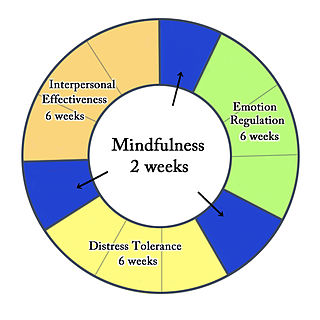Psychotherapy is the use of psychological methods, particularly when based on regular personal interaction, to help a person change behavior, increase happiness, and overcome problems. Psychotherapy aims to improve an individual's well-being and mental health, to resolve or mitigate troublesome behaviors, beliefs, compulsions, thoughts, or emotions, and to improve relationships and social skills. Numerous types of psychotherapy have been designed either for individual adults, families, or children and adolescents. Certain types of psychotherapy are considered evidence-based for treating some diagnosed mental disorders; other types have been criticized as pseudoscience.
Group psychotherapy or group therapy is a form of psychotherapy in which one or more therapists treat a small group of clients together as a group. The term can legitimately refer to any form of psychotherapy when delivered in a group format, including art therapy, cognitive behavioral therapy or interpersonal therapy, but it is usually applied to psychodynamic group therapy where the group context and group process is explicitly utilized as a mechanism of change by developing, exploring and examining interpersonal relationships within the group.

Dialectical behavior therapy (DBT) is an evidence-based psychotherapy that began with efforts to treat personality disorders and interpersonal conflicts. Evidence suggests that DBT can be useful in treating mood disorders and suicidal ideation as well as for changing behavioral patterns such as self-harm and substance use. DBT evolved into a process in which the therapist and client work with acceptance and change-oriented strategies and ultimately balance and synthesize them—comparable to the philosophical dialectical process of thesis and antithesis, followed by synthesis.
Rational emotive behavior therapy (REBT), previously called rational therapy and rational emotive therapy, is an active-directive, philosophically and empirically based psychotherapy, the aim of which is to resolve emotional and behavioral problems and disturbances and to help people to lead happier and more fulfilling lives.
Integrative psychotherapy is the integration of elements from different schools of psychotherapy in the treatment of a client. Integrative psychotherapy may also refer to the psychotherapeutic process of integrating the personality: uniting the "affective, cognitive, behavioral, and physiological systems within a person".
Transference is a phenomenon within psychotherapy in which repetitions of old feelings, attitudes, desires, or fantasies that someone displaces are subconsciously projected onto a here-and-now person. Traditionally, it had solely concerned feelings from a primary relationship during childhood.
Psychodynamic psychotherapy and psychoanalytic psychotherapy are two categories of psychological therapies. Their main purpose is revealing the unconscious content of a client's psyche in an effort to alleviate psychic tension, which is inner conflict within the mind that was created in a situation of extreme stress or emotional hardship, often in the state of distress. The terms "psychoanalytic psychotherapy" and "psychodynamic psychotherapy" are often used interchangeably, but a distinction can be made in practice: though psychodynamic psychotherapy largely relies on psychoanalytical theory, it employs substantially shorter treatment periods than traditional psychoanalytical therapies. Psychodynamic psychotherapy is evidence-based; the effectiveness of psychoanalysis and its relationship to facts is disputed.
Behaviour therapy or behavioural psychotherapy is a broad term referring to clinical psychotherapy that uses techniques derived from behaviourism and/or cognitive psychology. It looks at specific, learned behaviours and how the environment, or other people's mental states, influences those behaviours, and consists of techniques based on behaviorism's theory of learning: respondent or operant conditioning. Behaviourists who practice these techniques are either behaviour analysts or cognitive-behavioural therapists. They tend to look for treatment outcomes that are objectively measurable. Behaviour therapy does not involve one specific method, but it has a wide range of techniques that can be used to treat a person's psychological problems.

In applied psychology, interventions are actions performed to bring about change in people. A wide range of intervention strategies exist and they are directed towards various types of issues. Most generally, it means any activities used to modify behavior, emotional state, or feelings. Psychological interventions have many different applications and the most common use is for the treatment of mental disorders, most commonly using psychotherapy. The ultimate goal behind these interventions is not only to alleviate symptoms but also to target the root cause of mental disorders.
The therapeutic relationship refers to the relationship between a healthcare professional and a client or patient. It is the means by which a therapist and a client hope to engage with each other and effect beneficial change in the client.
Interpersonal psychotherapy (IPT) is a brief, attachment-focused psychotherapy that centers on resolving interpersonal problems and symptomatic recovery. It is an empirically supported treatment (EST) that follows a highly structured and time-limited approach and is intended to be completed within 12–16 weeks. IPT is based on the principle that relationships and life events impact mood and that the reverse is also true. It was developed by Gerald Klerman and Myrna Weissman for major depression in the 1970s and has since been adapted for other mental disorders. IPT is an empirically validated intervention for depressive disorders, and is more effective when used in combination with psychiatric medications. Along with cognitive behavioral therapy (CBT), IPT is recommended in treatment guidelines as a psychosocial treatment of choice for depression.
Multitheoretical psychotherapy (MTP) is a new approach to integrative psychotherapy developed by Jeff E. Brooks-Harris and his colleagues at the University of Hawaii at Manoa. MTP is organized around five principles for integration:
- Intentional
- Multidimensional
- Multitheoretical
- Strategy-based
- Relational
Emotionally focused therapy and emotion-focused therapy (EFT) are a set of related approaches to psychotherapy with individuals, couples, or families. EFT approaches include elements of experiential therapy, systemic therapy, and attachment theory. EFT is usually a short-term treatment. EFT approaches are based on the premise that human emotions are connected to human needs, and therefore emotions have an innately adaptive potential that, if activated and worked through, can help people change problematic emotional states and interpersonal relationships. Emotion-focused therapy for individuals was originally known as process-experiential therapy, and it is still sometimes called by that name.
Transference focused psychotherapy (TFP) is a highly structured, twice-weekly modified psychodynamic treatment based on Otto F. Kernberg's object relations model of borderline personality disorder. It views the individual with borderline personality organization (BPO) as holding unreconciled and contradictory internalized representations of self and significant others that are affectively charged. The defense against these contradictory internalized object relations leads to disturbed relationships with others and with self. The distorted perceptions of self, others, and associated affects are the focus of treatment as they emerge in the relationship with the therapist (transference). The treatment focuses on the integration of split off parts of self and object representations, and the consistent interpretation of these distorted perceptions is considered the mechanism of change.
Common factors theory, a theory guiding some research in clinical psychology and counseling psychology, proposes that different approaches and evidence-based practices in psychotherapy and counseling share common factors that account for much of the effectiveness of a psychological treatment. This is in contrast to the view that the effectiveness of psychotherapy and counseling is best explained by specific or unique factors that are suited to treatment of particular problems.

Insight-oriented psychotherapy is a category of psychotherapies that rely on conversation between the therapist and the client. It involves developing the patient's understanding of past and present experiences, how they are related to each other and the effect they have on the patient's interpersonal relationships, emotions and symptoms. Insight-oriented psychotherapy can be an intensive process, wherein the client must spend multiple days per week with the therapist.
Clinical behavior analysis is the clinical application of behavior analysis (ABA). CBA represents a movement in behavior therapy away from methodological behaviorism and back toward radical behaviorism and the use of functional analytic models of verbal behavior—particularly, relational frame theory (RFT).
Experiential avoidance (EA) has been broadly defined as attempts to avoid thoughts, feelings, memories, physical sensations, and other internal experiences — even when doing so creates harm in the long run. The process of EA is thought to be maintained through negative reinforcement — that is, short-term relief of discomfort is achieved through avoidance, thereby increasing the likelihood that the avoidance behavior will persist. Importantly, the current conceptualization of EA suggests that it is not negative thoughts, emotions, and sensations that are problematic, but how one responds to them that can cause difficulties. In particular, a habitual and persistent unwillingness to experience uncomfortable thoughts and feelings is thought to be linked to a wide range of problems.
Paradox psychology is a counter-intuitive approach that is primarily geared toward addressing treatment resistance. The method of paradoxical interventions (pdxi) is more focused, rapid, and effective than Motivational Interviewing. In addressing resistance, the method seeks to influence the clients' underlying attitude and perception by providing laser beam attention on strengthening the attachment-alliance. This is counter-intuitive to traditional methods since change is usually directed toward various aspects of behavior, emotions, and thinking. As it turns out, the better therapy is able to strengthen the alliance, the more these aspects of behavior will change.
Eclectic psychotherapy is a form of psychotherapy in which the clinician uses more than one theoretical approach, or multiple sets of techniques, to help with clients' needs. The use of different therapeutic approaches will be based on the effectiveness in resolving the patient's problems, rather than the theory behind each therapy.


